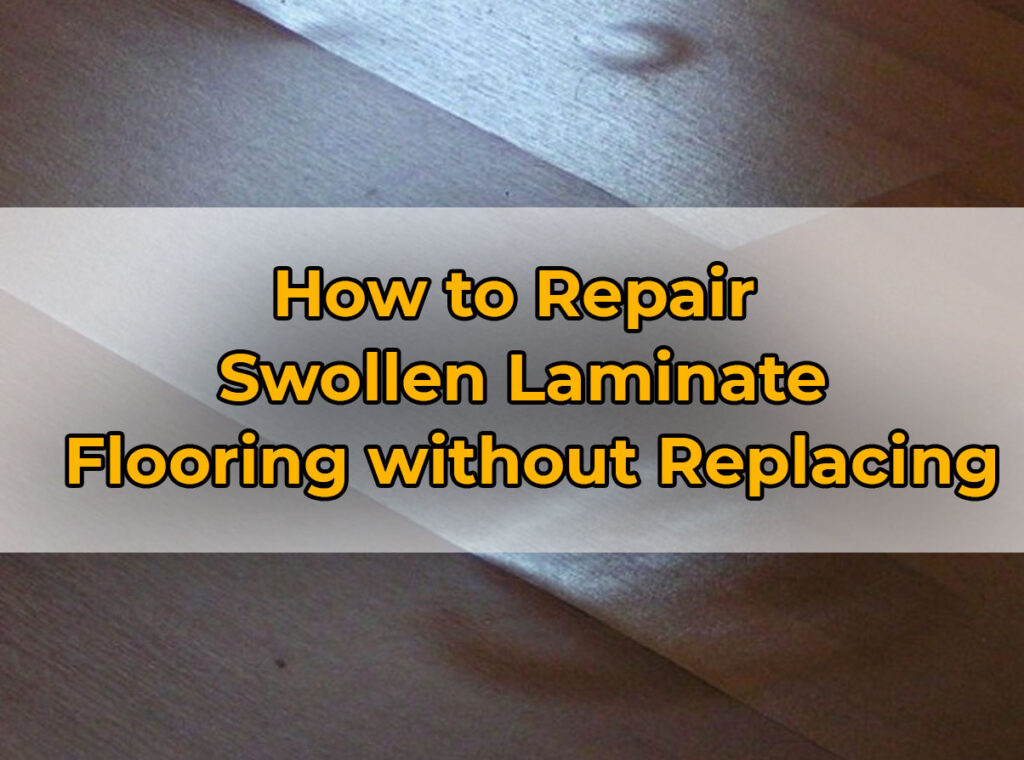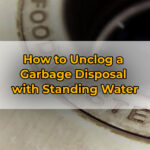Having swelling on your floor? looking How to Repair Swollen Laminate Flooring without Replacing? Laminate flooring is a popular and affordable home flooring option, however, swelling can be an issue caused by moisture, humidity, or poor installation.
Planks can expand, losing their shape, creating an uneven surface. Fortunately, you can repair the floor without replacing it!
Identify the root cause first. Fix any moisture issues and address poor installation methods. Then, you can use a DIY approach. Removing and replacing damaged planks with new ones, taking measurements for proper fitting and alignment, and using moisture-resistant adhesive or underlayment can help.
Minor swelling may be fixable without removing planks. Carefully pry up the swollen planks and use a dehumidifier or fan to return them to their original size.
Repairing your laminate flooring doesn’t require professional help or breaking the bank. With some knowledge and DIY techniques, you can bring it back to life!
Causes of Swollen Laminate Flooring

Laminate flooring is a popular choice for many homeowners, due to its modern looks. But, it’s not invincible.
Swelling can occur because of water damage, poor installation, high humidity, or exposure to sunlight. Warping, buckling and other damages might need repair or replacement of the whole floorboard. Check also: Why Is Kilz Not Recommended For Flooring?
1. Water leaks
The most common cause of swollen laminate flooring is water leaks. Leaking pipes, plumbing issues, or spills that are not promptly cleaned up can allow water to seep into the laminate, causing it to swell.
2. High humidity
Excessive moisture in the air can also lead to swollen laminate flooring. If the humidity levels in a room are consistently high, the moisture can penetrate the laminate over time and cause it to expand.
3. Flooding
If a room experiences a significant amount of water flooding, such as from a burst pipe or a natural disaster, the laminate flooring can absorb the water and become swollen.
4. Improper installation
Poor installation techniques can leave gaps or spaces between the laminate planks, making it easier for water or moisture to seep through and cause swelling. If the laminate is not properly acclimated or if an inadequate moisture barrier is used during installation, it can also contribute to swelling.
5. Subfloor moisture
Moisture from the subfloor can migrate up into the laminate flooring if there is not an effective vapor barrier installed between the subfloor and the laminate. This moisture can cause the laminate to swell and buckle.
How to Repair Swollen Laminate Flooring without Replacing

Fortunately, repairing swollen laminate flooring does not necessarily require replacement. The first step is to identify the source of the moisture and fix it to prevent further damage. Next, you will need to remove the baseboards carefully and assess how much of your floor has been affected by swelling.
If only a few planks are swollen, these can be replaced individually with new ones that match your existing laminate flooring. If there is extensive damage, you may need to replace larger sections or even consider replacing the entire floor.
1. Identify and address the source of moisture
The first step in repairing swollen laminate flooring without replacing it is to identify and address the source of moisture.
To identify the source of moisture, start by inspecting the affected area thoroughly. Check for any leaks or water damage around the walls, pipes, or windows. Use a moisture meter to determine how much moisture is present in the flooring and surrounding areas. Once you have identified where the moisture is coming from, take steps to address it immediately.
If there are plumbing issues causing water damage or leaking pipes, call a plumber as soon as possible.
2. Dry out the area
After identifying and removing any excess water or moisture from the affected area, it’s time to dry out the space. This critical step not only ensures that your flooring returns to its original condition but also prevents further damage and mold growth.
There are various ways you can dry out your laminate flooring effectively. The first option is using fans or dehumidifiers inside the room where the damage occurred. These machines work by circulating air through the affected area and drawing out any moisture present in your floorboards or subflooring.
Alternatively, you could try opening up windows and doors to increase airflow throughout your home, which will expedite drying time.
It’s essential to keep track of progress during this phase since it may take several days for all moisture levels to normalize fully.
3. Reduce the swelling
If the swelling is minor, you may be able to reduce it by applying a damp cloth or towel to the affected area. Place the cloth over the swollen spot and apply a hot iron to the cloth on the lowest heat setting.
The heat can help the laminate fibers expand and return to their original shape. Be cautious not to apply too much heat or pressure, as it may damage the laminate further.
4. Sand down the swollen area
One effective method is sanding down the swollen area. This process involves using a sander to remove any excess material from the affected boards until they are level with the surrounding ones.
Sanding down swollen areas can be time-consuming but is often less expensive than replacing an entire floor. Additionally, once sanded, the repaired area can be refinished or painted over to match your existing flooring seamlessly.
5. Fill gaps with laminate filler
Laminate filler is a putty-like substance that can be applied to the gaps in your swollen laminate flooring. It dries quickly and hardens to create a smooth surface that blends seamlessly with the rest of your floor. It comes in a variety of colors to match different types of laminate flooring, so you can choose one that matches your specific needs.
Before applying laminate filler, make sure to clean the affected area thoroughly. Remove any debris or dirt from the gap between floor, and allow it to dry completely.
6. Apply a laminate repair kit
To apply a laminate repair kit, start by cleaning the affected area thoroughly. Use a vacuum or broom to remove any dirt or debris from the surface of the floor. Next, use a utility knife or similar tool to carefully remove any swollen pieces of laminate. Be sure to wear gloves and eye protection during this step as it can be dangerous.
Once you have removed all of the damaged pieces, follow the instructions included with your repair kit to fill in any gaps or cracks in the subflooring beneath the laminate.
Please note that these repair methods may not always yield perfect results, and the appearance of the repaired area may differ from the rest of the laminate flooring.
Additionally, the effectiveness of these repairs will depend on the severity of the swelling and the condition of the laminate. If the damage is extensive or if the laminate is beyond repair, it may be necessary to consider replacing the affected area or the entire floor.
Methods to Repair Swollen Laminate Flooring

To repair swollen laminate flooring with ease, use the following methods: Dry moisture from the floor, remove damaged planks or tiles, reinstall laminate planks or tiles, and seal the floor joints and edges.
1. Drying Moisture from the Floor
Tackling floor moisture can be a real headache, especially for those with swollen laminate flooring. Taking quick action is essential to avoid mold growth and other damage. Follow this 6-step guide to get you started:
- Mop up any excess water, or use a wet/dry vacuum.
- Open windows and doors to promote air flow.
- Set up fans around the room to improve circulation.
- Deploy dehumidifiers to reduce humidity levels.
- Use hot water and cleaning solution to damp-mop the floor. Change the mop head regularly to avoid leaving water on the floor.
- Replace damaged laminate flooring parts.
Make sure to find and stop the source of moisture. Natural drying methods may not be enough, especially for floors that are soaked. Equipment like fans and dehumidifiers should be used.
Unfortunately, constant moisture exposure can weaken adhesives and baseboards in laminate flooring materials. Moisture Meter Guide found this through their experiment measuring how much moisture different materials can absorb before deteriorating.
It’s time to bid farewell to those damaged planks. Nothing looks worse than a lopsided floor.
2. Removing Damaged Planks or Tiles
Laminate flooring – a modern, affordable floor covering – can become damaged over time due to water exposure, humidity, or leaks. To repair the swollen floors, start by removing the damaged planks or tiles with these six steps:
- Cut the center of the plank/tile lengthwise with a sharp utility knife.
- Score around the edges so you don’t damage any surrounding planks.
- Carefully pry open each side with a putty knife until you can remove it completely.
- Check if the underlayment needs replacing and do so if necessary.
- Cut a replacement piece to fit and slide it into place.
- Secure it with a tapping block and mallet along the edges.
Inspect for water-damage in the surrounding areas. Also, make sure you understand what type of laminate flooring you have and its manufacturer design, so you can buy compatible replacement pieces. Now, get ready to fix your floors and prevent your guests from slipping around like they’re on ice!
3. Reinstalling Laminate Planks or Tiles
When laminate flooring swells, you don’t have to replace it. Reinstalling is a cost-efficient way to repair it. Here’s how:
- Remove damaged planks/tiles with a pry bar. Use a hammer and chisel for stubborn adhesive.
- Clean and prepare subfloor. Remove any residue or debris.
- Install new planks/tiles from one end to another. Make sure each one is level and tightly connected.
- Use a tapping block and hammer for a secure fit.
Measurements must be precise and accurate. Different types of laminate may require different techniques. Check manufacturer’s instructions.
Pro Tip: Match replacement planks/tiles with existing design/color scheme. Seal joints and edges for extra protection.
4. Sealing the Floor Joints and Edges
Sealing the joints and edges of your laminate floor is key to long-lasting results and restoring it. This will stop moisture from getting in and causing warping or cupping. Here are 3 steps to do it:
- Clean the area and remove dirt from between the boards.
- Apply sealant on joints and edges until fully covered. Use a brush to remove excess.
- Let dry completely before adding furniture or walking on it.
Remember to use the right sealant for your type of flooring. Plus, leave an expansion gap between flooring and walls for boards to expand or contract without cracking. Also, don’t put laminate in places with too much moisture.
By doing this and following extra tips, you can make your laminate floor last years and reduce the risk of future damages. Get the tools and materials to do the job right!
Tools and Materials Needed for Repairing Swollen Laminate Flooring
To repair swollen laminate flooring without replacing, you need to equip yourself with the right tools and materials. In order to get the job done efficiently, you will need moisture meters and hygrometers, handsaw or jigsaw, laminate floor repair kit, silicone sealant, and caulk. These tools and materials will enable you to restore your laminate flooring to its original quality.
1. Moisture Meters and Hygrometers
Swollen laminate flooring? Moisture is the culprit! To diagnose and repair, use moisture meters and hygrometers. Check out this table for more info:
| Type of Tool | Function |
|---|---|
| Pin-Type Moisture Meter | For wood and other materials |
| Pinless Moisture Meter | Non-invasive for various materials |
| Digital Hygrometer | Measures relative humidity in the air |
| Psychrometer | Measures dew point and humidity |
Correct tool for each material is key. Pin-type meters work best with wood-based products. Pinless is better for concrete.
These tools have been around since the mid-1800s. Lucien Sarton invented a device in 1887 that measured humidity. So much has changed since then!
Need to get through that swollen flooring? Grab a handsaw or jigsaw. You’ll need a therapist for your anger, too.
2. Handsaw or Jigsaw
For a successful floor repair, you need the right tools. Handsaw or jigsaw are essential for trimming and fitting. Choose the right blade, for clean cuts and no damage.
When using a handsaw, make long, controlled strokes. Jigsaws are better for intricate and curved cuts.
If you’re confused, ask an expert or watch online tutorials. Safety goggles are a must when using any saw – to protect your eyes.
Pro Tip: All you need is the perfect Laminate Floor Repair Kit!
3. Laminate Floor Repair Kit
Repairing swollen laminate flooring requires a Laminate Floor Repair Kit. This kit includes: replacement planks, adhesive, silicone sealant, a circular saw, a jigsaw, and a spatula/knife. Plus, it may contain other useful items like marker pens, tape measure, cardboard, hammer and chisel.
First, inspect the problem area. Cut out any bulging plank with precision. Apply the glue correctly when fitting replacement boards. Seal the deal with silicone sealant and caulk. Don’t walk away from a swollen laminate floor – repair it!
4. Silicone Sealant and Caulk
Silicone Sealant is an adhesive that gives a waterproof seal. It’s flexible, mold and mildew resistant, and can handle extreme temperatures. Caulk too, is a versatile material used to fill gaps between surfaces like walls, baseboards, and floors. It’s also waterproof and comes in various colors to match your flooring.
When using Silicone Sealant or Caulk on swollen laminate flooring, pick a color that matches your flooring to avoid ugly patches. Clean the gap properly before applying the material for better adhesion.
Remember to make your workspace well-ventilated as these products have a strong smell. And, don’t use too much or too little caulk – this can lead to an uneven floor surface. Lastly, check your floors aren’t masquerading as water parks before attempting any repairs!
Why does laminate bubble?
One reason why laminate may bubble is due to moisture. Laminate flooring is made up of several layers, including a core layer that can swell when exposed to moisture. If the subfloor underneath the laminate has excessive moisture or if there’s been a spill on the floor that seeps through the seams in the planks, it can cause bubbling.
Another reason why laminate may bubble is due to poor installation techniques. If the planks are not installed correctly or there are gaps between them, it creates spaces where air can get trapped and cause bubbles to form.
Will swollen laminate go down?
The good news is that swollen laminate can go down, but the effectiveness of the solution depends on the cause of the swelling.
If your swollen laminate is caused by excess moisture, you may need to address underlying issues such as poor ventilation or leaks before attempting any repairs. If left unchecked, these issues can cause irreparable damage to your flooring and subflooring. Once you’ve dealt with moisture-related problems, you may need to wait for several weeks or months for the swollen laminate to naturally reduce in size as it dries out.
Why does my laminate floor feel spongy?
One possibility is that the underlayment – the material that sits between the subfloor and the laminate – is not properly installed or has been damaged. If the underlayment is too thin, not level, or has gaps in it, it can cause the entire floor to feel spongy.
Another possible cause is water damage. Laminate floors are not waterproof, and if water seeps into the core of the planks, they can swell and warp, causing a bouncy sensation when walked on.
“There is no real ending. It’s just the place where you stop the story.”






